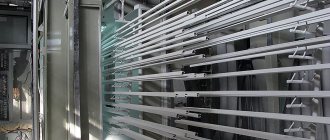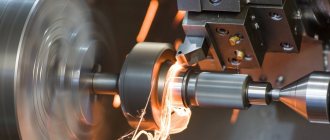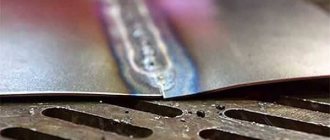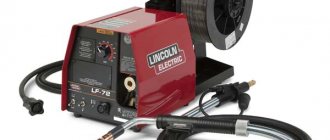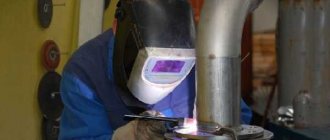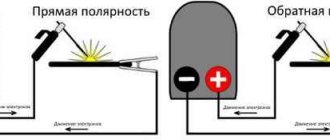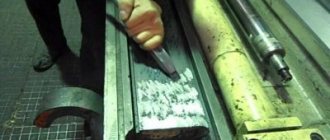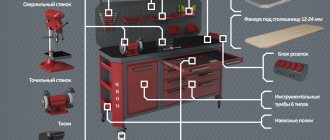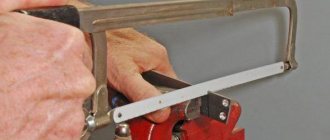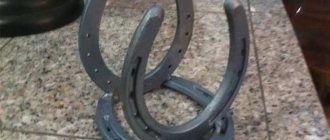Metalwork related to the preparation of metal and wooden surfaces by removing irregularities is carried out using a special tool equipped with a cutting edge. Scraping, or grinding, contains different technologies for finishing workpieces for parts; the operation is carried out both directly with devices and with the use of abrasives of different grain sizes. All working processes allow you to obtain a workpiece with a perfectly smooth surface; scrapers for metal and wood help create tight adhesion to other parts.
What is a scraper?
A tool designed to remove a thin layer of metal from the surface of a workpiece, used to remove the surface film before soldering or welding elements of a loaded structure, as well as before assembling parts of precision instruments.
Using the scraping method, the sharp edge of a metal scraper blade removes the top layer of material 0.01 mm thick. Metal scraping is also used when sanding wood after processing with other tools. During the cleaning process, the surface is checked with a surface plate covered with a layer of paint. The presence of irregularities is revealed by painting individual sections of the workpiece, which are removed by repeated scraping of the problem area.
Metalwork scrapers differ:
- A shape that can be flat, shaped, multifaceted
- A design that contains replaceable plates
- Number of grinding edges: one-sided, two-sided and three-sided.
In terms of design, the device can be collapsible or integral.
Recommendations for use
The main advice when scraping metal is to select the right device. This is the only way to scrape the part perfectly and not ruin the scraper. Many professional workers in this field have entire sets of such tools. However, if you are an ordinary hobbyist, then you can buy a universal tool that allows you to change plates for each part.
Never attempt to clean metal that has serious defects over a large area. Such a part is subjected to rough processing on a milling machine. It is necessary to cover with a light layer of paint to determine the places where you need to start scraping the metal. It is necessary to paint after each scraping cycle.
The recommended sharpening of the angle should be ninety degrees. If necessary, the angle can be made smaller or larger.
Metal stripping tool
A metalwork scraper is made of a standard length, the width of the blade depends on the type of operation: for roughing, a tool with a blade width of up to 3.0 cm is used, finishing cleaning is carried out with a cutting part 2.0 cm wide. The technology is selected depending on the sharpening angle of the blade, which is designed for each type of operation:
- 750-900 - roughing;
- 900 - finishing operation;
- 900-1000 - finishing cleaning.
The sharpening angle of the tool blade is measured relative to the axis of the product handle.
Surface paint
After completing the preparation of the material, residual irregularities are identified by applying a painted control plate. Scraping paint is made from pigment mixed with any type of industrial oil. The pigment used is azure, blue, red lead or a mixture of soot, autol and kerosene. The scouring paint should have the consistency of a medium thick paste, not spread or form lumps. The mixture should lie on the plane of the control plate in a thin, even layer.
Types of metal scrapers
A flat-type device with three edges or a shaped blade is suitable for working with a straight flat surface or sharp corners of a product; it cuts aluminum, copper and bobbit well. The triangular blade tool is used for machining cylindrical type holes in carbide metal workpiece.
When scraping the surface of parts, the tool used, the principle of scraping and grinding at a certain angle, must have replaceable sharpened plates that allow the formation of an angle with respect to a flat surface. Operations are most often carried out with a universal scraper, the design of which contains:
- Frame;
- Pen;
- Holder;
- Clamp screw;
- Replaceable plate.
Scope of application of scrapers
In any production workshop that directly works with the production of metal parts and each worker has a bench scraper. Using this tool, the surface of the parts is leveled, after which they can adhere to each other without interfering with the operation of the mechanism.
Doctors are used for the final preparation of products for release. Machine guides, bearings, for the manufacture of testing devices, to give a flat surface - this is a small part where they can be used:
- Blades of cutting tools.
- Sliding bearings.
- Parts of high-precision instruments.
The areas of use are limitless, as they are versatile and capable of performing other types of work. These include engraving on the surface of soft metals, removing old coatings, and are used in cosmetology.
Electric ones, with the right approach, are suitable for removing paint, plaster from ceilings and walls, polishing, in addition to their main activity.
Electric scraper
Manicure - made in the form of a small spatula with a handle. Therefore, a person who does not understand the species will not understand that he is dealing with a scraper. Now let's look at what types there are in production plants.
How to scrape correctly
The type of scraping does not involve preparing the surface of the material being processed. The work is carried out in a strict sequence of operations:
- Apply paint to the control plate;
- Place the unpolished part on the plate and smoothly move it back and forth;
- Visually assess painted defects;
- Prepare the tool;
- Proceed to remove irregularities by moving the scraper with a blade angle of 35-400.
Working with a metal surface involves scraping off any bulges. The principle of scraping is to create long segments formed by sliding the blade and then reducing the amplitude. The direction of movement of the tool should change gradually and cross. During work, it is recommended to check the level of smoothing of irregularities with a painted plate or a 25x25 mm test square.
Surface testing technique
The control square helps determine the depth of scraping of the surface of a part or workpiece. In the middle of the frame attached to the surface of the part, a control area is selected and the number of painted spots is counted. The type of irregularities can be determined by the number of convexities:
- If the number of spots reaches 6, the scraping is rough;
- If there are up to 10 spots, the scraping is clean;
- When the number of spots is at least 14, the processing is accurate;
- When the number of painted spots is 22, the cleaning is for jewelry.
The operation of leveling the front part of the parts, the tool and the scraping method used depend on the type of surface. To process the edges, a straight-type device is used, the scraper cleans bent parts with a shaped blade, hard materials are processed with a narrow blade, scraping soft materials and flat surfaces is carried out with a wide scraper and a radius-type blade.
The shape of the device’s blade is selected according to the type of surface, which can be identified by rolling the part over a painted plate. Identified irregularities are removed with a device with a long sharpened edge. The types of scrapers used start moving from the edge of the workpiece. After completion of the operation, a control check of the cleanliness of the treatment is carried out, for finishing which the scraper uses a bench tool and a ferrite edge < 1.5 cm.
Destination Features
The scraper is a universal machine that is widely used in various fields. Plumbing, lithography, sculpture are some of the few areas where specialists use scraping technology. This metal-cutting tool helps to achieve an ideal surface for proper mating of individual parts of an object.
Scrapers occupy a special niche in the toolkit that is needed in the field of metalworking. Using a multifaceted machine, the thinnest layers of metal products are removed, which helps give the object a perfect shape. This operation is widely applicable to various moving parts that act as part of larger mechanisms. The following elements are sharpened using scrapers:
- parts of high-voltage mechanisms;
- parts of automotive products (bearings);
- measuring devices (rulers, compasses and squares);
- building materials (tiles);
- cutting edges for devices.
Scrapers are used when engraving various products; also, with the help of a pointed tip, the master can easily remove layers of dried glue, silicone and other old coating. Nail service technicians are also well acquainted with the scraper - using a small spatula-shaped machine it is easy to process nails during manicure and pedicure.
The design of the tool is determined by its general purpose. The scrapers used in metalworking have their own anatomical structure, and machines designed for processing more pliable materials have a different structure. The shape of the universal scraper is justified by the multidirectionality of the operations performed - such machines are useful in any craft.
Recommendations from a professional scraper
In order for the cutting tool to last a long time and help prepare materials efficiently, it is recommended to pay special attention to the choice of device. All types of scrapers are adapted according to the shape of the cutting edge to perform technological tasks. The best option is to choose universal type equipment, the design of which allows you to quickly replace plates in accordance with the requirements of the technical process.
Due to technical features, different types of scrapers cannot be used on surfaces with large defects and deep scratches. The part must undergo rough processing on a milling machine or other grinding equipment. All surface leveling cycles must end with a test with a control plate containing pigment dye.
Making at home
You can invent a scraper at home with your own hands. The main thing is to know a few tricks. To make this device we will need the following tools:
- Square rod measuring 15 mm.
- T5K10 plate.
- Emery.
- Vise.
- Bulgarian.
- Bolt with washer.
Having prepared these tools, we take the grinder in our hands and saw off thirty centimeters from the rod. This part will serve as the housing for our homemade device. Next, we clamp it in a vice and make a cut. Its depth should be three centimeters. Then we make a groove for the cutting surface one centimeter in size and drill a hole for the bolt that will clamp the structure.
Now the cuts need to be sanded and the plate installed in the groove. All that remains is to tighten the bolt and the device for removing roughness is ready.
Now let's look at how to make a scraper from a file.
The width of the device from which the device will be made must be at least ten millimeters. The length is equal to the length of the palm, and the handle should fit comfortably in the hand. Now we begin to manufacture a device for removing roughness on metal.
We transform the working edge into a part of a future device for working with metal. If you are going to do rough work with it when removing it, then you need to make a straight line, but if you are going to finish it, grind it out round.
After this, sharpen until a notch of 1 centimeter appears. We make the end flat and the sides rounded. Now it needs to be secured in a vice. Sharpened on an abrasive stone. It must first be filled with diamond paste.

